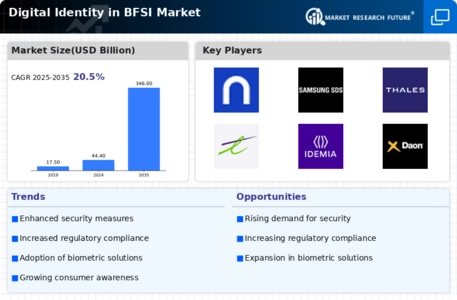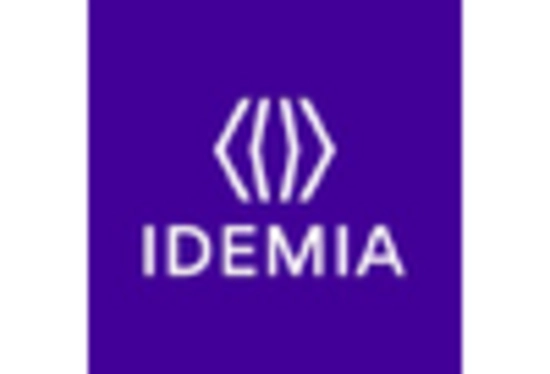-
EXECUTIVE SUMMARY
-
MARKET INTRODUCTION
-
Definition
-
Scope of the Study
- Research Objective
- Assumptions
- Limitations
-
RESEARCH METHODOLOGY
-
Overview
-
Data Mining
-
Secondary Research
-
Primary Research
- Primary Interviews and Information Gathering Process
- Breakdown of Primary Respondents
-
Forecasting Modality
-
Market Size Estimation
- Bottom-Up Approach
- Top-Down Approach
-
Data Triangulation
-
Validation
-
MARKET DYNAMICS
-
Overview
-
Drivers
-
Restraints
-
Opportunities
-
MARKET FACTOR ANALYSIS
-
Value Chain Analysis
-
Porter’s Five Forces Analysis
- Bargaining Power of Suppliers
- Bargaining Power of Buyers
- Threat of New Entrants
- Threat of Substitutes
- Intensity of Rivalry
-
COVID-19 Impact Analysis
- Market Impact Analysis
- Regional Impact
- Opportunity and Threat Analysis
-
GLOBAL DIGITAL IDENTITY IN BFSI MARKET, BY OFFERINGS
-
Overview
-
Solutions
-
Services
-
GLOBAL DIGITAL IDENTITY IN BFSI MARKET, BY SOLUTION TYPE
-
Overview
-
Identity Verification
-
Authentication
-
Identity Lifecycle Management
-
Other Solution Types
-
GLOBAL DIGITAL IDENTITY IN BFSI MARKET, BY IDENTITY TYPE
-
Overview
-
Biometric
-
Non- biometric
-
GLOBAL DIGITAL IDENTITY IN BFSI MARKET, BY ORGANIZATION SIZE
-
Overview
-
Large Enterprises
-
SMEs
-
GLOBAL DIGITAL IDENTITY IN BFSI MARKET, BY REGION
-
Overview
-
North America
-
U.S.
-
Canada
-
Europe
- Germany
- France
- U.K
- Italy
- Spain
- Rest of Europe
-
Asia-Pacific
- China
- India
- Japan
- South Korea
- Australia
- Rest of Asia-Pacific
-
Rest of the World
- Middle East
- Africa
- Latin America
-
COMPETITIVE LANDSCAPE
-
Overview
-
Competitive Analysis
-
Market Share Analysis
-
Major Growth Strategy in the Global DIGITAL IDENTITY IN BFSI MARKET,
-
Competitive Benchmarking
-
Leading Players in Terms of Number of Developments in the Global DIGITAL IDENTITY IN BFSI MARKET,
-
Key developments and Growth Strategies
- New Offering Launch/Solution Type Deployment
- Merger & Acquisitions
- Joint Ventures
-
Major Players Financial Matrix
- Sales & Operating Income, 2022
- Major Players R&D Expenditure. 2022
-
COMPANY PROFILES
-
NEC
- Company Overview
- Financial Overview
- Product Offered
- Key Developments
- : SWOT ANALYSIS
- Key Strategies
-
Samsung SDS
- Company Overview
- Financial Overview
- Product Offered
- Key Developments
- : SWOT ANALYSIS
- Key Strategies
-
Thales
- Company Overview
- Financial Overview
- Product Offered
- Key Developments
- : SWOT ANALYSIS
- Key Strategies
-
Telus
- Company Overview
- Financial Overview
- Product Offered
- Key Developments
- : SWOT ANALYSIS
- Key Strategies
-
IDEMIA
- Company Overview
- Financial Overview
- Product Offered
- Key Developments
- : SWOT ANALYSIS
- Key Strategies
-
GBG
- Company Overview
- Financial Overview
- Product Offered
- Key Developments
- : SWOT ANALYSIS
- Key Strategies
-
Tessi
- Company Overview
- Financial Overview
- Product Offered
- Key Developments
- : SWOT ANALYSIS
- Key Strategies
-
Daon
- Company Overview
- Financial Overview
- Product Offered
- Key Developments
- : SWOT ANALYSIS
- Key Strategies
-
ForgeRock
- Company Overview
- Financial Overview
- Product Offered
- Key Developments
- : SWOT ANALYSIS
- Key Strategies
-
ImageWare
- Company Overview
- Financial Overview
- Product Offered
- Key Developments
- : SWOT ANALYSIS
- Key Strategies
-
Jumio
- Company Overview
- Financial Overview
- Product Offered
- Key Developments
- : SWOT ANALYSIS
- Key Strategies
-
iProov
- Company Overview
- Financial Overview
- Product Offered
- Key Developments
- : SWOT ANALYSIS
- Key Strategies
-
ID R&D
- Company Overview
- Financial Overview
- Product Offered
- Key Developments
- : SWOT ANALYSIS
- Key Strategies
-
Refinitiv
- Company Overview
- Financial Overview
- Product Offered
- Key Developments
- : SWOT ANALYSIS
- Key Strategies
-
OneSpan
- Company Overview
- Financial Overview
- Product Offered
- Key Developments
- : SWOT ANALYSIS
- Key Strategies
-
Smartmatic
- Company Overview
- Financial Overview
- Product Offered
- Key Developments
- : SWOT ANALYSIS
- Key Strategies
-
Freja EID Group
- Company Overview
- Financial Overview
- Product Offered
- Key Developments
- : SWOT ANALYSIS
- Key Strategies
-
Vintegris
- Company Overview
- Financial Overview
- Product Offered
- Key Developments
- : SWOT ANALYSIS
- Key Strategies
-
AU10TIX
- Company Overview
- Financial Overview
- Product Offered
- Key Developments
- : SWOT ANALYSIS
- Key Strategies
-
Signicat
- Company Overview
- Financial Overview
- Product Offered
- Key Developments
- : SWOT ANALYSIS
- Key Strategies
-
Duo Security
- Company Overview
- Financial Overview
- Product Offered
- Key Developments
- : SWOT ANALYSIS
- Key Strategies
-
Syntizen
- Company Overview
- Financial Overview
- Product Offered
- Key Developments
- : SWOT ANALYSIS
- Key Strategies
-
Hashcash Consultant
- Company Overview
- Financial Overview
- Product Offered
- Key Developments
- : SWOT ANALYSIS
- Key Strategies
-
Good Digital Identity
- Company Overview
- Financial Overview
- Product Offered
- Key Developments
- : SWOT ANALYSIS
- Key Strategies
-
APPENDIX
-
References
-
Related Reports
-
-
LIST OF TABLES
-
GLOBAL DIGITAL IDENTITY IN BFSI MARKET, SYNOPSIS, 2025 - 2034
-
GLOBAL DIGITAL IDENTITY IN BFSI MARKET, ESTIMATES & FORECAST, 2025 - 2034 (USD BILLION)
-
GLOBAL DIGITAL IDENTITY IN BFSI MARKET, BY OFFERING, 2025 - 2034 (USD BILLION)
-
GLOBAL DIGITAL IDENTITY IN BFSI MARKET, BY SOLUTION TYPE, 2025 - 2034 (USD BILLION)
-
GLOBAL DIGITAL IDENTITY IN BFSI MARKET, BY IDENTITY TYPE, 2025 - 2034 (USD BILLION)
-
GLOBAL DIGITAL IDENTITY IN BFSI MARKET, BY ORGANIZATION SIZE, 2025 - 2034 (USD BILLION)
-
NORTH AMERICA DIGITAL IDENTITY IN BFSI MARKET, BY OFFERING, 2025 - 2034 (USD BILLION)
-
NORTH AMERICA DIGITAL IDENTITY IN BFSI MARKET, BY SOLUTION TYPE, 2025 - 2034 (USD BILLION)
-
NORTH AMERICA DIGITAL IDENTITY IN BFSI MARKET, BY IDENTITY TYPE, 2025 - 2034 (USD BILLION)
-
NORTH AMERICA DIGITAL IDENTITY IN BFSI MARKET, BY ORGANIZATION SIZE, 2025 - 2034 (USD BILLION)
-
NORTH AMERICA DIGITAL IDENTITY IN BFSI MARKET, BY COUNTRY, 2025 - 2034 (USD BILLION)
-
U.S. DIGITAL IDENTITY IN BFSI MARKET, BY OFFERING, 2025 - 2034 (USD BILLION)
-
U.S. DIGITAL IDENTITY IN BFSI MARKET, BY SOLUTION TYPE, 2025 - 2034 (USD BILLION)
-
U.S. DIGITAL IDENTITY IN BFSI MARKET, BY IDENTITY TYPE, 2025 - 2034 (USD BILLION)
-
U.S. DIGITAL IDENTITY IN BFSI MARKET, BY ORGANIZATION SIZE, 2025 - 2034 (USD BILLION)
-
CANADA DIGITAL IDENTITY IN BFSI MARKET, BY OFFERING, 2025 - 2034 (USD BILLION)
-
CANADA DIGITAL IDENTITY IN BFSI MARKET, BY SOLUTION TYPE, 2025 - 2034 (USD BILLION)
-
CANADA DIGITAL IDENTITY IN BFSI MARKET, BY IDENTITY TYPE, 2025 - 2034 (USD BILLION)
-
CANADA DIGITAL IDENTITY IN BFSI MARKET, BY ORGANIZATION SIZE, 2025 - 2034 (USD BILLION)
-
EUROPE DIGITAL IDENTITY IN BFSI MARKET, BY OFFERING, 2025 - 2034 (USD BILLION)
-
EUROPE DIGITAL IDENTITY IN BFSI MARKET, BY SOLUTION TYPE, 2025 - 2034 (USD BILLION)
-
EUROPE DIGITAL IDENTITY IN BFSI MARKET, BY IDENTITY TYPE, 2025 - 2034 (USD BILLION)
-
EUROPE DIGITAL IDENTITY IN BFSI MARKET, BY ORGANIZATION SIZE, 2025 - 2034 (USD BILLION)
-
EUROPE DIGITAL IDENTITY IN BFSI MARKET, BY COUNTRY, 2025 - 2034 (USD BILLION)
-
GERMANY DIGITAL IDENTITY IN BFSI MARKET, BY OFFERING, 2025 - 2034 (USD BILLION)
-
GERMANY DIGITAL IDENTITY IN BFSI MARKET, BY SOLUTION TYPE, 2025 - 2034 (USD BILLION)
-
GERMANY DIGITAL IDENTITY IN BFSI MARKET, BY IDENTITY TYPE, 2025 - 2034 (USD BILLION)
-
GERMANY DIGITAL IDENTITY IN BFSI MARKET, BY ORGANIZATION SIZE, 2025 - 2034 (USD BILLION)
-
FRANCE DIGITAL IDENTITY IN BFSI MARKET, BY OFFERING, 2025 - 2034 (USD BILLION)
-
FRANCE DIGITAL IDENTITY IN BFSI MARKET, BY SOLUTION TYPE, 2025 - 2034 (USD BILLION)
-
FRANCE DIGITAL IDENTITY IN BFSI MARKET, BY IDENTITY TYPE, 2025 - 2034 (USD BILLION)
-
FRANCE DIGITAL IDENTITY IN BFSI MARKET, BY ORGANIZATION SIZE, 2025 - 2034 (USD BILLION)
-
U.K DIGITAL IDENTITY IN BFSI MARKET, BY OFFERING, 2025 - 2034 (USD BILLION)
-
U.K DIGITAL IDENTITY IN BFSI MARKET, BY SOLUTION TYPE, 2025 - 2034 (USD BILLION)
-
U.K DIGITAL IDENTITY IN BFSI MARKET, BY IDENTITY TYPE, 2025 - 2034 (USD BILLION)
-
U.K DIGITAL IDENTITY IN BFSI MARKET, BY ORGANIZATION SIZE, 2025 - 2034 (USD BILLION)
-
ITALY DIGITAL IDENTITY IN BFSI MARKET, BY OFFERING, 2025 - 2034 (USD BILLION)
-
ITALY DIGITAL IDENTITY IN BFSI MARKET, BY SOLUTION TYPE, 2025 - 2034 (USD BILLION)
-
ITALY DIGITAL IDENTITY IN BFSI MARKET, BY IDENTITY TYPE, 2025 - 2034 (USD BILLION)
-
ITALY DIGITAL IDENTITY IN BFSI MARKET, BY ORGANIZATION SIZE, 2025 - 2034 (USD BILLION)
-
SPAIN DIGITAL IDENTITY IN BFSI MARKET, BY OFFERING, 2025 - 2034 (USD BILLION)
-
SPAIN DIGITAL IDENTITY IN BFSI MARKET, BY SOLUTION TYPE, 2025 - 2034 (USD BILLION)
-
SPAIN DIGITAL IDENTITY IN BFSI MARKET, BY IDENTITY TYPE, 2025 - 2034 (USD BILLION)
-
SPAIN DIGITAL IDENTITY IN BFSI MARKET, BY ORGANIZATION SIZE, 2025 - 2034 (USD BILLION)
-
REST OF EUROPE DIGITAL IDENTITY IN BFSI MARKET, BY OFFERING, 2025 - 2034 (USD BILLION)
-
REST OF EUROPE DIGITAL IDENTITY IN BFSI MARKET, BY SOLUTION TYPE, 2025 - 2034 (USD BILLION)
-
REST OF EUROPE DIGITAL IDENTITY IN BFSI MARKET, BY IDENTITY TYPE, 2025 - 2034 (USD BILLION)
-
REST OF EUROPE DIGITAL IDENTITY IN BFSI MARKET, BY ORGANIZATION SIZE, 2025 - 2034 (USD BILLION)
-
ASIA PACIFIC DIGITAL IDENTITY IN BFSI MARKET, BY OFFERING, 2025 - 2034 (USD BILLION)
-
ASIA PACIFIC DIGITAL IDENTITY IN BFSI MARKET, BY SOLUTION TYPE, 2025 - 2034 (USD BILLION)
-
ASIA PACIFIC DIGITAL IDENTITY IN BFSI MARKET, BY IDENTITY TYPE, 2025 - 2034 (USD BILLION)
-
ASIA PACIFIC DIGITAL IDENTITY IN BFSI MARKET, BY ORGANIZATION SIZE, 2025 - 2034 (USD BILLION)
-
ASIA PACIFIC DIGITAL IDENTITY IN BFSI MARKET, BY COUNTRY, 2025 - 2034 (USD BILLION)
-
CHINA DIGITAL IDENTITY IN BFSI MARKET, BY OFFERING, 2025 - 2034 (USD BILLION)
-
CHINA DIGITAL IDENTITY IN BFSI MARKET, BY SOLUTION TYPE, 2025 - 2034 (USD BILLION)
-
CHINA DIGITAL IDENTITY IN BFSI MARKET, BY IDENTITY TYPE, 2025 - 2034 (USD BILLION)
-
CHINA DIGITAL IDENTITY IN BFSI MARKET, BY ORGANIZATION SIZE, 2025 - 2034 (USD BILLION)
-
JAPAN DIGITAL IDENTITY IN BFSI MARKET, BY OFFERING, 2025 - 2034 (USD BILLION)
-
JAPAN DIGITAL IDENTITY IN BFSI MARKET, BY SOLUTION TYPE, 2025 - 2034 (USD BILLION)
-
JAPAN DIGITAL IDENTITY IN BFSI MARKET, BY IDENTITY TYPE, 2025 - 2034 (USD BILLION)
-
JAPAN DIGITAL IDENTITY IN BFSI MARKET, BY ORGANIZATION SIZE, 2025 - 2034 (USD BILLION)
-
INDIA DIGITAL IDENTITY IN BFSI MARKET, BY OFFERING, 2025 - 2034 (USD BILLION)
-
INDIA DIGITAL IDENTITY IN BFSI MARKET, BY SOLUTION TYPE, 2025 - 2034 (USD BILLION)
-
INDIA DIGITAL IDENTITY IN BFSI MARKET, BY IDENTITY TYPE, 2025 - 2034 (USD BILLION)
-
INDIA DIGITAL IDENTITY IN BFSI MARKET, BY ORGANIZATION SIZE, 2025 - 2034 (USD BILLION)
-
SOUTH KOREA DIGITAL IDENTITY IN BFSI MARKET, BY OFFERING, 2025 - 2034 (USD BILLION)
-
SOUTH KOREA DIGITAL IDENTITY IN BFSI MARKET, BY SOLUTION TYPE, 2025 - 2034 (USD BILLION)
-
SOUTH KOREA DIGITAL IDENTITY IN BFSI MARKET, BY IDENTITY TYPE, 2025 - 2034 (USD BILLION)
-
SOUTH KOREA DIGITAL IDENTITY IN BFSI MARKET, BY ORGANIZATION SIZE, 2025 - 2034 (USD BILLION)
-
AUSTRALIA DIGITAL IDENTITY IN BFSI MARKET, BY OFFERING, 2025 - 2034 (USD BILLION)
-
AUSTRALIA DIGITAL IDENTITY IN BFSI MARKET, BY SOLUTION TYPE, 2025 - 2034 (USD BILLION)
-
AUSTRALIA DIGITAL IDENTITY IN BFSI MARKET, BY IDENTITY TYPE, 2025 - 2034 (USD BILLION)
-
AUSTRALIA DIGITAL IDENTITY IN BFSI MARKET, BY ORGANIZATION SIZE, 2025 - 2034 (USD BILLION)
-
REST OF ASIA PACIFIC DIGITAL IDENTITY IN BFSI MARKET, BY OFFERING, 2025 - 2034 (USD BILLION)
-
REST OF ASIA PACIFIC DIGITAL IDENTITY IN BFSI MARKET, BY SOLUTION TYPE, 2025 - 2034 (USD BILLION)
-
REST OF ASIA PACIFIC DIGITAL IDENTITY IN BFSI MARKET, BY IDENTITY TYPE, 2025 - 2034 (USD BILLION)
-
REST OF ASIA PACIFIC DIGITAL IDENTITY IN BFSI MARKET, BY ORGANIZATION SIZE, 2025 - 2034 (USD BILLION)
-
REST OF THE WORLD DIGITAL IDENTITY IN BFSI MARKET, BY OFFERING, 2025 - 2034 (USD BILLION)
-
REST OF THE WORLD DIGITAL IDENTITY IN BFSI MARKET, BY SOLUTION TYPE, 2025 - 2034 (USD BILLION)
-
REST OF THE WORLD DIGITAL IDENTITY IN BFSI MARKET, BY IDENTITY TYPE, 2025 - 2034 (USD BILLION)
-
REST OF THE WORLD DIGITAL IDENTITY IN BFSI MARKET, BY ORGANIZATION SIZE, 2025 - 2034 (USD BILLION)
-
REST OF THE WORLD DIGITAL IDENTITY IN BFSI MARKET, BY COUNTRY, 2025 - 2034 (USD BILLION)
-
MIDDLE EAST DIGITAL IDENTITY IN BFSI MARKET, BY OFFERING, 2025 - 2034 (USD BILLION)
-
MIDDLE EAST DIGITAL IDENTITY IN BFSI MARKET, BY SOLUTION TYPE, 2025 - 2034 (USD BILLION)
-
MIDDLE EAST DIGITAL IDENTITY IN BFSI MARKET, BY IDENTITY TYPE, 2025 - 2034 (USD BILLION)
-
MIDDLE EAST DIGITAL IDENTITY IN BFSI MARKET, BY ORGANIZATION SIZE, 2025 - 2034 (USD BILLION)
-
AFRICA DIGITAL IDENTITY IN BFSI MARKET, BY OFFERING, 2025 - 2034 (USD BILLION)
-
AFRICA DIGITAL IDENTITY IN BFSI MARKET, BY SOLUTION TYPE, 2025 - 2034 (USD BILLION)
-
AFRICA DIGITAL IDENTITY IN BFSI MARKET, BY IDENTITY TYPE, 2025 - 2034 (USD BILLION)
-
AFRICA DIGITAL IDENTITY IN BFSI MARKET, BY ORGANIZATION SIZE, 2025 - 2034 (USD BILLION)
-
LATIN AMERICA DIGITAL IDENTITY IN BFSI MARKET, BY OFFERING, 2025 - 2034 (USD BILLION)
-
LATIN AMERICA DIGITAL IDENTITY IN BFSI MARKET, BY SOLUTION TYPE, 2025 - 2034 (USD BILLION)
-
LATIN AMERICA DIGITAL IDENTITY IN BFSI MARKET, BY IDENTITY TYPE, 2025 - 2034 (USD BILLION)
-
LATIN AMERICA DIGITAL IDENTITY IN BFSI MARKET, BY ORGANIZATION SIZE, 2025 - 2034 (USD BILLION)
-
-
LIST OF FIGURES
-
RESEARCH PROCESS
-
MARKET STRUCTURE FOR THE GLOBAL DIGITAL IDENTITY IN BFSI MARKET
-
MARKET DYNAMICS FOR THE GLOBAL DIGITAL IDENTITY IN BFSI MARKET
-
GLOBAL DIGITAL IDENTITY IN BFSI MARKET, SHARE (%), BY OFFERING, 2022
-
GLOBAL DIGITAL IDENTITY IN BFSI MARKET, SHARE (%), BY SOLUTION TYPE, 2022
-
GLOBAL DIGITAL IDENTITY IN BFSI MARKET, SHARE (%), BY IDENTITY TYPE, 2022
-
GLOBAL DIGITAL IDENTITY IN BFSI MARKET, SHARE (%), BY ORGANIZATION SIZE, 2022
-
GLOBAL DIGITAL IDENTITY IN BFSI MARKET, SHARE (%), BY REGION, 2022
-
NORTH AMERICA: DIGITAL IDENTITY IN BFSI MARKET, SHARE (%), BY REGION, 2022
-
EUROPE: DIGITAL IDENTITY IN BFSI MARKET, SHARE (%), BY REGION, 2022
-
ASIA-PACIFIC: DIGITAL IDENTITY IN BFSI MARKET, SHARE (%), BY REGION, 2022
-
REST OF THE WORLD: DIGITAL IDENTITY IN BFSI MARKET, SHARE (%), BY REGION, 2022
-
GLOBAL DIGITAL IDENTITY IN BFSI MARKET: COMPANY SHARE ANALYSIS, 2022 (%)
-
NEC: : FINANCIAL OVERVIEW SNAPSHOT
-
NEC : SWOT ANALYSIS
-
SAMSUNG SDS : FINANCIAL OVERVIEW SNAPSHOT
-
SAMSUNG SDS : SWOT ANALYSIS
-
THALES : FINANCIAL OVERVIEW SNAPSHOT
-
THALES : SWOT ANALYSIS
-
TELUS : FINANCIAL OVERVIEW SNAPSHOT
-
TELUS : SWOT ANALYSIS
-
IDEMIA : FINANCIAL OVERVIEW SNAPSHOT
-
IDEMIA : SWOT ANALYSIS
-
GBG : FINANCIAL OVERVIEW SNAPSHOT
-
GBG : SWOT ANALYSIS
-
TESSI : FINANCIAL OVERVIEW SNAPSHOT
-
TESSI : SWOT ANALYSIS
-
DAON : FINANCIAL OVERVIEW SNAPSHOT
-
DAON : SWOT ANALYSIS
-
FORGEROCK : FINANCIAL OVERVIEW SNAPSHOT
-
FORGEROCK : SWOT ANALYSIS
-
IMAGEWARE : FINANCIAL OVERVIEW SNAPSHOT
-
IMAGEWARE : SWOT ANALYSIS
-
JUMIO : FINANCIAL OVERVIEW SNAPSHOT
-
JUMIO : SWOT ANALYSIS
-
IPROOV : FINANCIAL OVERVIEW SNAPSHOT
-
IPROOV : SWOT ANALYSIS
-
ID R&D : FINANCIAL OVERVIEW SNAPSHOT
-
ID R&D : SWOT ANALYSIS
-
REFINITIV : FINANCIAL OVERVIEW SNAPSHOT
-
REFINITIV : SWOT ANALYSIS
-
ONESPAN : FINANCIAL OVERVIEW SNAPSHOT
-
ONESPAN : SWOT ANALYSIS
-
SMARTMATIC : FINANCIAL OVERVIEW SNAPSHOT
-
SMARTMATIC : SWOT ANALYSIS
-
FREJA EID GROUP : FINANCIAL OVERVIEW SNAPSHOT
-
FREJA EID GROUP : SWOT ANALYSIS
-
VINTEGRIS : FINANCIAL OVERVIEW SNAPSHOT
-
VINTEGRIS : SWOT ANALYSIS
-
AU10TIX : FINANCIAL OVERVIEW SNAPSHOT
-
AU10TIX : SWOT ANALYSIS
-
SIGNICAT : FINANCIAL OVERVIEW SNAPSHOT
-
SIGNICAT : SWOT ANALYSIS
-
DUO SECURITY : FINANCIAL OVERVIEW SNAPSHOT
-
DUO SECURITY : SWOT ANALYSIS
-
SYNTIZEN : FINANCIAL OVERVIEW SNAPSHOT
-
SYNTIZEN : SWOT ANALYSIS
-
HASHCASH CONSULTANT : FINANCIAL OVERVIEW SNAPSHOT
-
HASHCASH CONSULTANT : SWOT ANALYSIS
-
GOOD DIGITAL IDENTITY : FINANCIAL OVERVIEW SNAPSHOT
-
GOOD DIGITAL IDENTITY : SWOT ANALYSIS









Leave a Comment